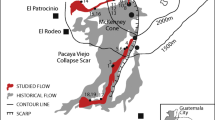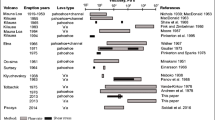Abstract
Lava rheology and effusion rate are critical factors in determining the evolution of lava flows. However, direct and accurate field measurements are difficult to carry out, and estimates are usually based on measurements of the flow’s surface velocity and assumptions of sub-surface geometry. Using numerical flow models, we show that the potential for error due to geometry uncertainty is minimized if a semi-elliptical cross-sectional channel shape is assumed. Flow is simulated for isothermal Newtonian, temperature-dependent Newtonian, and isothermal power-law rheology lavas. For isothermal Newtonian lava, we find that the error in channel shape alone can make apparent viscosity estimates ∼3.5 times too large (e.g., for inappropriate use of the Jeffreys equation on a narrow semi-elliptical channel). For a temperature-dependent rheology, using an analytical approximation for Newtonian flow in a semi-elliptical geometry yields apparent viscosity and flux values that are more accurate than estimates which assume a rectangular geometry, for all channel shapes considered, including rectangular channels. Viscosity calculations for real channels on Mauna Loa and Mount Etna show that for a Newtonian rheology, a semi-elliptical analytical solution gives an approximation three times closer to the actual viscosity than a rectangle with the same depth while, if the lava is shear-thinning (power law exponent m = 0.6), a rectangular approximation is 15 % more accurate. Our results can be used to bracket possible viscosity and flux estimates when channel topography is poorly constrained.






Similar content being viewed by others
References
Bailey JE, Harris A, Dehn J, Calvari S, Rowland S (2006) The changing morphology of an open lava channel on Mt. Etna Bull Volcanol 68:497–515. doi:10.1007/s00445-005-0025-6
Baloga SM, Glaze LS, Crisp JA, Stockman SA (1998) New statistics for estimating the bulk rheology of active lava flows: Pu‘u ‘O‘o examples. J Geophys Res 103 (B3):5133–5142
Baloga SM, Mouginis-Mark PJ, Glaze LS (2003) Rheology of a long lava flow at Pavonis Mons. Mars J Geophys Res (Planets) 108 (E7):5066. doi:10.1029/2002JE001981
Barrett R, Berry M, Chan T, Demmel J, Donato J, Dongarra J, Eijkhout V, Pozo R, Romine C, Van der Vorst H (1994) Templates for the solutions of linear systems: Building blocks for iterative methods. Society for Industrial and Applied Mathematics (SIAM), Philadelphia
Batchelor G (1967) An introduction to fluid mechanics. Cambridge University Press, Cambridge
Behncke B, Neri M, Nagay A (2005) Lava flow hazard at Mount Etna (Italy): new data from a GIS-based study. In: Manga M, Ventura G (eds) Kinematics and dynamics of lava flows. GSA Special Papers 395, pp 189–208
Chevrel MO, Platz T, Hauber E, Baratoux D, Lavallée Y, Dingwell DB (2013) Lava flow rheology: a comparison of morphological and petrological methods. Earth Planet Sci Lett 384:109–120
Crisci G, Iovine G, Di Gregorio S, Lupiano V (2008) Lava-flow hazard on the SE flank of Mt. Etna (Southern Italy). J Volcanol Geotherm Res 177:778–796
Crisp J, Cashman KV, Bonini JA, Hougen SB, Pieri DC (1994) Crystallization history of the 1984 Mauna Loa lava flow. J Geophys Res 99:7177–7198. doi:10.1029/93JB02973
Fink JH, Griffiths RW (1990) Radial spreading of viscous-gravity currents with solidifying crust. J Fluid Mech 221:485–509. doi:10.1017/S0022112090003640
Fink JH, Zimbelman JR (1986) Rheology of the 1983 Royal Gardens basalt flows, Kilauea Volcano, Hawaii. Bull Volcanol 48:87–96. doi:10.1007/BF01046544
Fulcher GS (1925) Analysis of recent measurements of the viscosity of glasses. J Amer Ceram Soc 8:339–355. doi:10.1111/j.1151-2916.1925.tb16731.x
Fundis AT, Soule SA, Fornari D, Perfit MR (2010) Paving the seafloor: Volcanic emplacement processes during the 2005–2006 eruptions at the fast spreading east pacific rise, 9’50. N Geochem Geophys Geosys 11(8):Q08024
Giordano D, Russell J, Dingwell D (2008) Viscosity of magmatic liquids: a model. Earth Planet Sci Lett 271:123–134
Gregg TKP, Fink JH (2000) A laboratory investigation into the effects of slope on lava flow morphology. J Volcanol Geotherm Res 96:145–159. doi:10.1016/S0377-0273(99)00148-1
Gregg TKP, Keszthelyi LP (2004) The emplacement of pahoehoe toes: Field observations and comparison to laboratory simulations. Bull Volcanol 66:381–391. doi:10.1007/s00445-003-0319-5
Griffiths RW, Kerr RC, Cashman KV (2003) Patterns of solidification in channel flows with surface cooling. J Fluid Mech 496:33–62. doi:10.1017/S0022112003006517
Harris AJL, Allen JS (2008) One-, two-, and three-phase viscosity treatments for basaltic lava flows. J Geophys Res 113 (b12):B09212. doi:10.1029/2007JB005035
Harris AJL, Dehn J, Calvari S (2007) Lava effusion rate definition and measurement: a review. Bull Volcanol 70:1–22. doi:10.1007/s00445-007-0120-y
Harris AJL, Rowland SK (2001) FLOWGO: a kinematic thermo-rheological model for lava flowing in a channel. Bull Volcanol 63:20–44. doi:10.1007/s004450000120
Hauber E, Bleacher J, Gwinner K, Williams D, Greeley R (2009) The topography and morphology of low shields and associated landforms of plains volcanism in the Tharsis region of Mars. J Volc Geotherm Res 185(1):69–95
Hauber E, BroŻ P, Jagert F, Jodłowski P, Platz T (2011) Very recent and wide-spread basaltic volcanism on Mars. Geophys Res Lett 38(10)
Hiesinger H, Head JW, Neukum G (2007) Young lava flows on the eastern flank of Ascraeus Mons: Rheological properties derived from high resolution stereo camera (HRSC) images and mars orbiter laser altimeter (MOLA) data. J Geophys Res (Planets) 112(e11):5011. doi:10.1029/2006JE002717
Hulme G (1974) The interpretation of lava flow morphology. Geophys J Int 39:361–383. doi:10.1111/j.1365-246X.1974.tb05460.x
Jaeger WL, Keszthelyi LP, Skinner JA, Milazzo MP, McEwen AS, Titus TN, Rosiek MR, Galuszka DM, Howington-Kraus E, Kirk RL, Team HiRISE (2010) Emplacement of the youngest flood lava on Mars: a short, turbulent story. Icarus 205:230–243. doi:10.1016/j.icarus.2009.09.011
James MR, Pinkerton H, Robson S (2007) Image-based measurement of flux variation in distal regions of active lava flows. Geochem Geophys Geosys 8:Q03006. doi:10.1029/2006GC001448
Jeffreys H (1925) Lxxxiv. the flow of water in an inclined channel of rectangular section. Lond Edinb Dublin Philos Mag J Sci 49(293):793–807
Johnson A (1970) Physical processes in geology. W.H. Freeman, New York
Johnson A, Rodine J (1984) Debris flow. In: Brunsden D, Prior D (eds) Slope instability. Wiley, New York, pp 257–361
Kauahikaua J (2007) Lava flow hazard assessment, as of August 2007, for Kīlauea East Rift Zone Eruptions, Hawai‘i Island US Geol Surv. Open File Rep 1264 (9)
Kilburn CRJ (2000) Lava flows and flow fields. In: Sigurdsson H., Houghton B F, McNutt S R, Rymer H, Stix J., McBirney A R (eds) Encyclopedia of volcanoes. Academic Press, San Diego, pp 291–305
Lipman PW, Banks NG (1987) AA flow dynamics, Mauna Loa 1984. In: Decker R W, Wright T L, Stauffer P H (eds) Volcanism in Hawaii. US Geol Surv Prof Pap, vol 1350, pp 1527– 1567
Mazzarini F, Pareschi MT, Favalli M, Isola I, Tarquini S, Boschi E (2005) IMorphology of basaltic lava channels during the Mt. Etna September 2004 eruption from airborne laser altimeter data. Geophys Res Lett 32:L04305. doi:10.1029/2004GL021815
Moore HJ (1987) Preliminary estimates of the rheological properties of 1984 Mauna Loa lava. In: Decker R W, Wright T L, Stauffer P H (eds) Volcanism in Hawaii. US Geol Surv Prof Pap, vol 1350, pp 1569–1588
Nichols RL (1939) Viscosity of lava. J of Geol 290–302
Patrick MR, Dehn J, Dean K (2004) Numerical modeling of lava flow cooling applied to the 1997 Okmok eruption: Approach and analysis. J Geophys Res 109(b18):3202. doi:10.1029/2003JB002537
Pinkerton H (1978) Field measurements of the rheology of lava. Nature 276:383–385. doi:10.1038/276383a0
Pinkerton H, Sparks RSJ (1976) The 1975 sub-terminal lavas, mount etna: a case history of the formation of a compound lava field. J Volcanol Geotherm Res 1(2):167–182
Pinkerton H, Wilson L (1994) Factors controlling the lengths of channel-fed lava flows. Bull Volcanol 56:108–120. doi:10.1007/BF00304106
Robertson J, Kerr R (2012a) Isothermal dynamics of channeled viscoplastic lava flows and new methods for estimating lava rheology. J Geophys Res 117(B1):B01202
Robertson J, Kerr R (2012b) Solidification dynamics in channeled viscoplastic lava flows. J Geophys Res 117(B7):B07206. doi:10.1029/2012JB00916
Sakimoto SEH, Gregg TKP (2001) Channeled flow: Analytic solutions, laboratory experiments, and applications to lava flows. J Geophys Res 106:8629–8644. doi:10.1029/2000JB900384
Shaw HR (1969) Rheology of basalt in the melting range. J Petrol 10:510–535
Sonder I, Zimanowski B, Büttner R (2006) Non-Newtonian viscosity of basaltic magma. Geophys Res Lett 33:L02303. doi:10.1029/2005GL024240
Spera FJ, Borgia A, Strimple J, Feigenson M (1988) Rheology melts and magmatic suspensions. I - design and calibration of concentric cylinder viscometer with application to rhyolitic magma. J Geophys Res 93:10273–10294. doi:10.1029/JB093iB09p10273
Takagi D, Huppert HE (2007) The effect of confining boundaries on viscous gravity currents. J Fluid Mech 577(1):495–505
Tallarico A, Dragoni M (1999) Viscous Newtonian laminar flow in a rectangular channel: Application to Etna lava flows. Bull Volcanol 61:40–47. doi:10.1007/s004450050261
Walker GPL (1968) Thickness and viscosity of Etnean lavas. Nature 213:484–485. doi:10.1038/213484a0
Walker GPL (1973) Lengths of lava flows. Phil Trans R Soc Lond 274:107–118
Zimbelman JR (1998) Emplacement of long lava flows on planetary surfaces. J Geophys Res 103:27503–27516. doi:10.1029/98JB01123
Acknowledgments
EL was supported during this work by the NSF grant EAR-1118943. Hannah Dietterich is thanked for processing the Mauna Loa lidar data. We thank the two reviewers of this paper, Jesse Robertson and Oryaelle Chevrel, and editor Matt Patrick, for their thorough and thoughtful reviews, which helped to improve this manuscript.
Author information
Authors and Affiliations
Corresponding author
Additional information
Editorial responsibility: M. R. Patrick
Electronic supplementary material
Below is the link to the electronic supplementary material.
Rights and permissions
About this article
Cite this article
Lev, E., James, M.R. The influence of cross-sectional channel geometry on rheology and flux estimates for active lava flows. Bull Volcanol 76, 829 (2014). https://doi.org/10.1007/s00445-014-0829-3
Received:
Accepted:
Published:
DOI: https://doi.org/10.1007/s00445-014-0829-3




